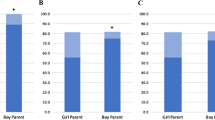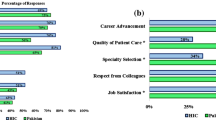Abstract
Background
This study aimed to highlight cultural barriers faced by surgeons pursuing a surgical career faced by surgeons at a tertiary care hospital in Pakistan. As more females opt for a surgical career, barriers faced by female surgeons are becoming increasingly evident, many of which are rooted in cultural norms. In Pakistan, a predominantly Muslim-majority, low middle-income country, certain societal expectations add additionally complexity and challenges to existing cultural barriers.
Methods
A cross-sectional survey was administered via e-mail to the full-time faculty and trainees in the Department of Surgery at the Aga Khan University Hospital, Karachi, Pakistan, from July 2019 to November 2019.
Results
In total, 100 participants were included in this study, with the majority being residents (55.6%) and consultants (33.3%). 71.9% of female surgeons felt that cultural barriers towards a surgical career existed for their gender, as compared to 25.4% of male surgeons (p < 0.001). 40.6% of females reported having been discouraged by family/close friends from pursuing surgery, as compared to only 9.0% of males (p < 0.001). Moreover, a greater percentage of females surgeons were responsible for household cooking, cleaning and laundry, as compared to male surgeons (all p < 0.001). Lastly, 71.4% of female surgeons felt that having children had hindered their surgical career, as compared to 4.8% of males (p < 0001).
Conclusion
Our study shows that significant cultural barriers exist for females pursuing a surgical career in our setting. Findings such as these emphasize the need for policy makers to work towards overcoming cultural barriers.


Similar content being viewed by others
References
AAMC (2019) Diversity in medicine: facts and figures 2019; Available from: https://www.aamc.org/data-reports/workforce/interactive-data/figure-1-percentage-applicants-us-medical-schools-sex-academic-years-1980-1981-through-2018-2019
Shaikh MA, Ikram S, Zaheer R (2018) Influences on medical career choice and future medical practice plans among women: perspective from final year students and house officers. Clin Res 1:8
Tomizawa Y (2013) Women in surgery: little change in gender equality in Japanese medical societies over the past 3 years. Surg Today 43(10):1202–1205 Epub 2012/12/12
Epstein NE (2017) Discrimination against female surgeons is still alive: where are the full professorships and chairs of departments? Surg Neurol Int. 26 May 2017;8:93
Gargiulo DA, Hyman NH, Hebert JC (2006) Women in surgery: do we really understand the deterrents? Arch Surg 141(4):405–408
Wolfe L (2018) Statistics on the number of women surgeons in the United States. Balance Careers. Retrieved from http://balancecareers.com/number-of-women-surgeons-in-the-US-3972900
Giantini Larsen AM, Pories S, Parangi S, Robertson FC (2019) Barriers to pursuing a career in surgery: an institutional survey of harvard medical school students. Ann Surg. 9 Oct 2019. https://doi.org/10.1097/SLA.0000000000003618. [Epub ahead of print]
Baptiste D, Fecher AM, Dolejs SC, Yoder J, Schmidt CM, Couch ME et al (2017) Gender differences in academic surgery, work-life balance, and satisfaction. J Surg Res 218:99–107
Nomura K, Gohchi K (2012) Impact of gender-based career obstacles on the working status of women physicians in Japan. Soc Sci Med 75(9):1612–1616
Mehmood N (2017) Women in Medicine: The Future. J Rawalpindi Med Coll (JRMC) 21(2):106–108
Bianchi SM, Milkie MA, Sayer LC, Robinson JP (2000) Is anyone doing the housework? Trends in the gender division of household labor. Soc Forces 79(1):191–228
Adesoye T, Mangurian C, Choo EK, Girgis C, Sabry-Elnaggar H, Linos E (2017) Perceived discrimination experienced by physician mothers and desired workplace changes: a cross-sectional survey. JAMA Intern Med 177(7):1033–1036
Jolly S, Griffith KA, DeCastro R, Stewart A, Ubel P, Jagsi R (2014) Gender differences in time spent on parenting and domestic responsibilities by high-achieving young physician-researchers. Ann Intern Med 160(5):344–353
Dyrbye LN, Shanafelt TD, Balch CM, Satele D, Sloan J, Freischlag J (2011) Relationship between work-home conflicts and burnout among American surgeons: a comparison by sex. Arch Surg 146(2):211–217
Ly DP, Seabury SA, Jena AB (2015) Divorce among physicians and other healthcare professionals in the United States: analysis of census survey data. BMJ 350:h706
Bellini MI, Graham Y, Hayes C, Zakeri R, Parks R, Papalois V (2019) A woman’s place is in theatre: women’s perceptions and experiences of working in surgery from the Association of Surgeons of Great Britain and Ireland women in surgery working group. BMJ Open 9(1):e024349
Ravindra P, Fitzgerald J (2011) Defining surgical role models and their influence on career choice. World J Surg 35(4):704–709. https://doi.org/10.1007/s00268-011-0983-0
Ashton-James CE, Tybur JM, Grießer V, Costa D (2019) Stereotypes about surgeon warmth and competence: the role of surgeon gender. PLoS ONE 14(2):e0211890
Peel JK, Schlachta CM, Alkhamesi NA (2018) A systematic review of the factors affecting choice of surgery as a career. Can J Surg 61(1):58
Schmidt LE, Cooper CA, Guo WA (2016) Factors influencing US medical students' decision to pursue surgery. J Surg Res 203(1):64–74
Myers SP, Hill KA, Nicholson KJ, Neal MD, Hamm ME, Switzer GE et al (2018) A qualitative study of gender differences in the experiences of general surgery trainees. J Surg Res 228:127–134
Moazam F, Shekhani S (2018) Why women go to medical college but fail to practise medicine: perspectives from the Islamic Republic of Pakistan. Med Educ 52(7):705–715 Epub 2018/03/07
Junaidi I (2014) 50pc of female doctors never work after graduation. Published in Dawn, 22 Oct 2014
Meara JG, Leather AJ, Hagander L, Alkire BC, Alonso N, Ameh EA et al (2015) Global Surgery 2030: evidence and solutions for achieving health, welfare, and economic development. Lancet 386(9993):569–624
Cochran A, Hauschild T, Elder WB, Neumayer LA, Brasel KJ, Crandall ML (2013) Perceived gender-based barriers to careers in academic surgery. Am J Surg 206(2):263–268
Schroen AT, Brownstein MR, Sheldon GF (2004) Women in academic general surgery. Acad Med 79(4):310–318
Cochran A, Neumayer LA, Elder WB (2019) Barriers to careers identified by women in academic surgery: a grounded theory model. Am J Surg 218(4):780–785
Shanafelt TD, Balch CM, Bechamps GJ, Russell T, Dyrbye L, Satele D et al (2009) Burnout and career satisfaction among American surgeons. Ann Surg 250(3):463–471
Cohen P (2017) Why women quit working: it’s not for the reasons men do. Published in the New York Times. 24 Jan 2017
Wallis CJ, Ravi B, Coburn N, Nam RK, Detsky AS, Satkunasivam R (2017) Comparison of postoperative outcomes among patients treated by male and female surgeons: a population based matched cohort study. BMJ 359:j4366
Rangel EL, Smink DS, Castillo-Angeles M, Kwakye G, Changala M, Haider AH et al (2018) Pregnancy and motherhood during surgical training. JAMA Surg 153(7):644–652 Epub 2018/03/22
Salles A, Awad M, Goldin L, Krus K, Lee JV, Schwabe MT et al (2019) Estimating implicit and explicit gender bias among health care professionals and surgeons. JAMA Netw Open. 2(7):e196545 Epub 2019/07/06
Schroen A, Brownstein M, Sheldon G (2004) Women in academic general surgery. Acad Med 79:310–318
Author information
Authors and Affiliations
Corresponding author
Ethics declarations
Conflict of interest
This article or its abstract has not been published in any journal or presented in any conference. The research received no funding or grant from any funding or grant agency in Pakistan. There is no conflict of interest reported by any of the authors.
Additional information
Publisher's Note
Springer Nature remains neutral with regard to jurisdictional claims in published maps and institutional affiliations.
Rights and permissions
About this article
Cite this article
Inam, H., Janjua, M., Martins, R.S. et al. Cultural Barriers for Women in Surgery: How Thick is the Glass Ceiling? An Analysis from a Low Middle-Income Country. World J Surg 44, 2870–2878 (2020). https://doi.org/10.1007/s00268-020-05544-9
Published:
Issue Date:
DOI: https://doi.org/10.1007/s00268-020-05544-9




